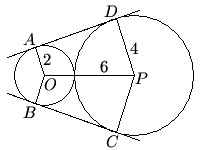2006 AMC 10B Problems/Problem 24
Problem
Circles with centers ![]() and
and ![]() have radii
have radii ![]() and
and ![]() , respectively, and are externally tangent. Points
, respectively, and are externally tangent. Points ![]() and
and ![]() on the circle with center
on the circle with center ![]() and points
and points ![]() and
and ![]() on the circle with center
on the circle with center ![]() are such that
are such that ![]() and
and ![]() are common external tangents to the circles. What is the area of the concave hexagon
are common external tangents to the circles. What is the area of the concave hexagon ![]() ?
?
![]()
Solution
Since a tangent line is perpendicular to the radius containing the point of tangency, ![]() .
.
Construct a perpendicular to ![]() that goes through point
that goes through point ![]() . Label the point of intersection
. Label the point of intersection ![]() .
.
Clearly ![]() is a rectangle.
is a rectangle.
Therefore ![]() and
and ![]() .
.
By the Pythagorean Theorem:
![]() .
.
The area of ![]() is
is ![]() .
.
The area of ![]() is
is ![]() .
.
So the area of quadrilateral ![]() is
is ![]() .
.
Using similar steps, the area of quadrilateral ![]() is also
is also ![]()
Therefore, the area of hexagon ![]() is
is ![]()










